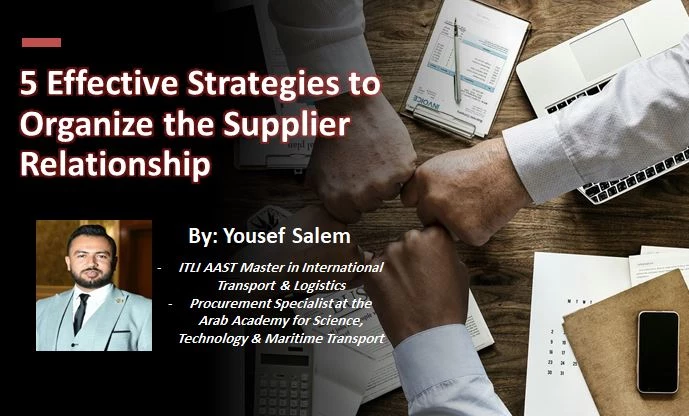
ITLI Listicle Articles | 5 Effective Strategies to Organize the Supplier Relationship
By: Yousef Salem
- ITLI AAST Master in International Transport & Logistics
- Procurement Specialist at the Arab Academy for Science, Technology & Maritime Transport
1. Multiple supplier strategy
This strategy is based on the principle of not putting all your choices in one basket, instead of building long-term relationships with one supplier and relying entirely on him in the production process, you have to diversify your resources and your decisions as well, so instead of focusing on one supplier, deal with many suppliers And strengthen the relationship between all of them, on the one hand, ensuring the continuation of the production process even if one of them decided to terminate the partnership or cooperate with your competitor, and on the one hand, you expand the circle of your relationship with suppliers and open new areas for services that may emerge and one of them is able to keep up with them.
2. Long term relationship building strategy
In it, reliance is made on a limited group of suppliers, or a single supplier if possible, in order to reach a consistent and stable model for the production management process, and in it the relationship between the enterprise and the supplier is built based on successful previous experiences, which led to the generation of a kind of permanent trust. However, building a relationship of this kind with suppliers is dangerous in that it makes the two parties control each other. On the one hand, the organization controls the operation and disbursement of the supplier's inventory, and on the one hand, the supplier controls the smoothness and continuity of the production process. Therefore, when relying on this strategy in the supply process, it is better to organize it with precise conditions that help preserve the rights of all, while applying it to more than one supplier, not just one.
3. Alliance building strategy
In it, a mutually beneficial relationship is established between the supplier and the institution, so that the institution helps the supplier with loans, logistical services, or relationships in accelerating the process of providing requests and speeding their completion, in addition to bridging and resolving the gaps that the supplier may suffer from in the process of delivering the requirements. It is a kind of very effective strategy in building trust between suppliers and the company, as well as in accelerating the production process and its effectiveness.
4. Value added strategy
In it, the focus is on the value that the supplier gives to your product more than the quality of the lowest price offer. When the organization is looking for a good deal on the supplier, it must also consider the additional value that this supplier gives. There may be a supplier that gives the best products at the best prices, but it does not He has a wide network of relationships capable of facilitating obstacles and accelerating the arrival of orders, so the institution must then deal with suppliers with a strategy more like sharing success, so that the enterprise shares with the supplier the increase in its sales, and the supplier shares its relations and experience with it.
5. Strategic alignment of strategic plans
In which suppliers are selected based on shared plans and future strategic goals, so that the moment does not come when the interests of both parties conflict with each other, which leads to obstruction or negative impact on the production process. Therefore, most professional companies are based from the beginning on agreeing on long-term future plans with suppliers, so that each of the goals and visions are compatible from the beginning of cooperation, and there is a roadmap agreed upon in advance.
To know more about the academic and professional programs of the International Transport and Logistics Institute (ITLI), please visit the following:
Webpage | LinkedIn | Facebook | Instagram




